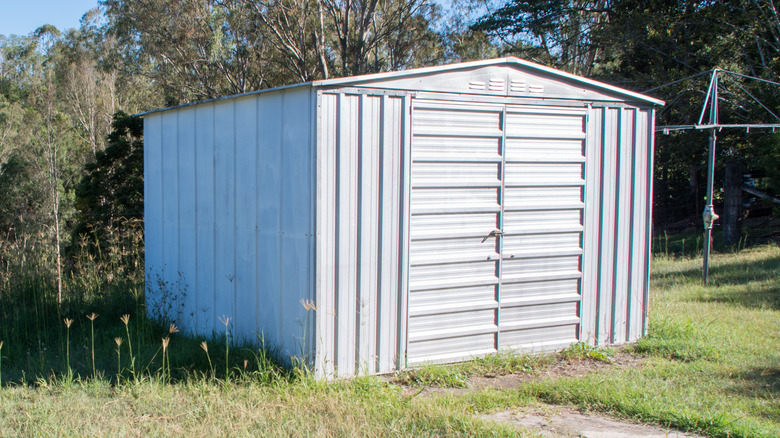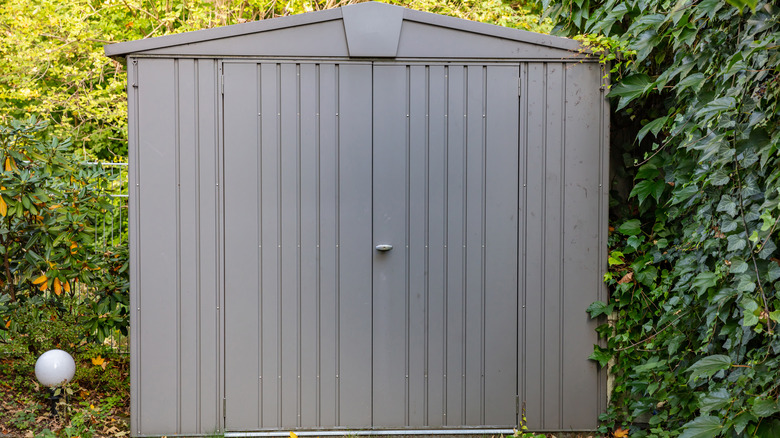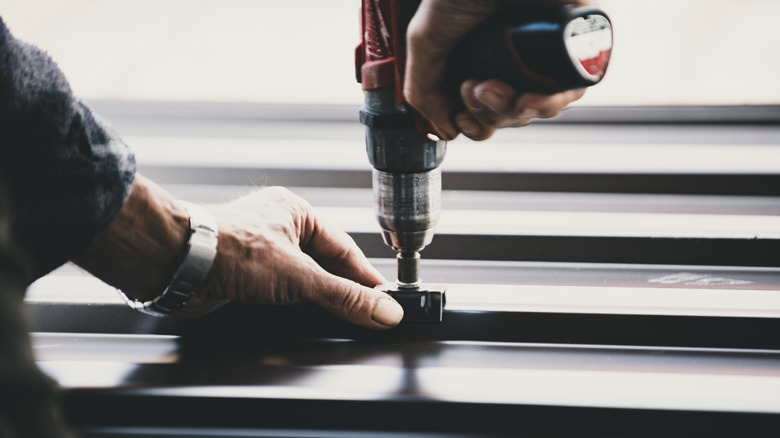The Pros & Cons Of Metal Storage Sheds (& Can You Build Your Own?)
It's no secret that Americans have a lot of stuff — in fact, 11.1% of households rent a storage space at a facility to make room for all of their things. If your home is in desperate need of storage space, and you have the acreage, you may be looking into adding a storage shed to your own backyard instead of renting. Sheds are great for storing tools and other outdoor items, but you can make the most of your shed by using the walls to hang things like bikes or even turning it into a gardener's paradise. But before you can start dreaming of the inside, you need to figure out the outside. Metal storage sheds are popular as they are usually one of the less expensive shed options, plus their durability and long-lasting nature put them at the top of the list. But at the same time, metal sheds aren't always the most aesthetically pleasing and can be prone to rust.
Deciding if a metal shed is right for you is mainly up to personal preference, although other factors like climate, time needed for maintenance, and cost are all big factors to consider when choosing the best material for your storage shed. Plus, if you plan to DIY a shed, metal is easy to do, although it is difficult to customize. Here's what to know about metal sheds before making a purchase.
Metal is weather and termite resistant
If you live in an area that is prone to extreme temperatures, whether hot or cold, metal is a great option as it can withstand those extremes. Similarly, if your backyard is often a breeding ground for pests, or they are common in your area, metal is an ideal pick. Pests, especially wood-loving ones like ants and termites, prefer wooden sheds over metal sheds. And while metal sheds are not completely impervious to pests, it is much harder for rodents to chew through, creating a stronger barrier between the unwanted pests and your belongings. Plus, you won't have to worry about your shed getting moldy or becoming a fire hazard.
On the other hand, if your shed is going to be a focal point of your backyard, you may want to look into a more handsome choice. Metal is not very customizable, so it will look like every other metal shed on the market. Some neighborhoods, especially those with an HOA, may not even allow metal sheds because of their appearance. Metal sheds are strong, although they may not be the most durable material for your shed. They are also hard to fix if they start to rust, although rust can be avoided if you quickly fix any cracks as you see them and install a window or vent to allow fresh air inside.
How to build your own metal shed
If the pros outweigh the cons for you and you have chosen metal as your shed option, your next question may be whether or not you can build it yourself. When it comes to doing it yourself, the easiest DIY storage shed material is wood, but you can install a metal shed quite easily as well. Metal sheds can be made out of steel or aluminum. Steel is stronger but prone to rusting, while aluminum does not rust but is not quite as strong. Galvanized steel is often the best choice for a shed as it is created to be rust-proof. Once you have your materials, you need to level the ground and create a strong foundation, which could mean adding crushed rock underneath or installing concrete pavers.
When it is finally time to build the shed, you will start with the corners and walls before reinforcing the door hinges and fastening the walls together. You will then build your roof and your doors, screwing everything together before anchoring the entire shed to the ground using an anchor kit. You can buy the materials and build the shed yourself or purchase a kit, like an Arrow galvanized steel shed from Lowe's for $489. Additional add-ons for the shed should include windows or air vents for adequate air flow and a pitched roof, which will prevent rainwater from getting inside.


